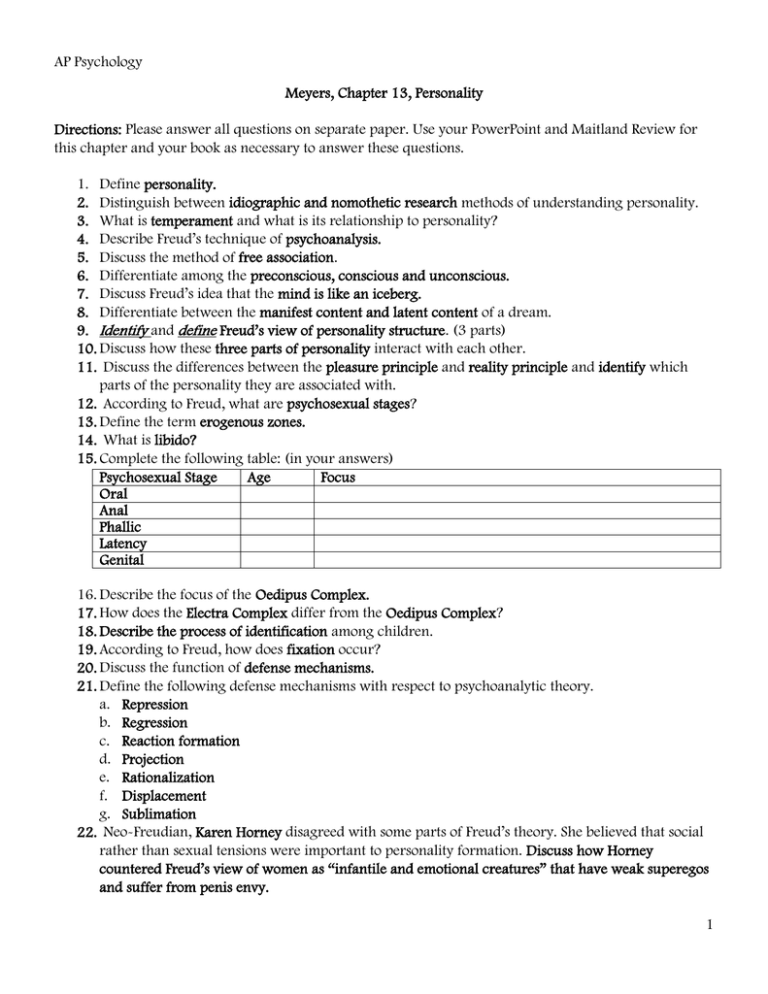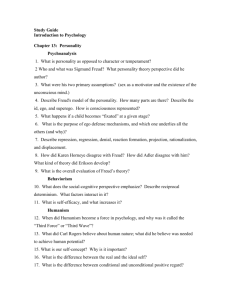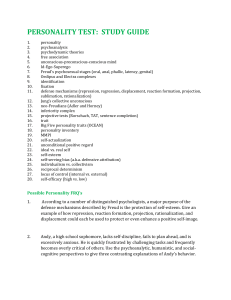File - Ms. G's Classroom
advertisement

AP Psychology Meyers, Chapter 13, Personality Directions: Please answer all questions on separate paper. Use your PowerPoint and Maitland Review for this chapter and your book as necessary to answer these questions. 1. Define personality. 2. Distinguish between idiographic and nomothetic research methods of understanding personality. 3. What is temperament and what is its relationship to personality? 4. Describe Freud’s technique of psychoanalysis. 5. Discuss the method of free association. 6. Differentiate among the preconscious, conscious and unconscious. 7. Discuss Freud’s idea that the mind is like an iceberg. 8. Differentiate between the manifest content and latent content of a dream. 9. Identify and define Freud’s view of personality structure. (3 parts) 10. Discuss how these three parts of personality interact with each other. 11. Discuss the differences between the pleasure principle and reality principle and identify which parts of the personality they are associated with. 12. According to Freud, what are psychosexual stages? 13. Define the term erogenous zones. 14. What is libido? 15. Complete the following table: (in your answers) Psychosexual Stage Age Focus Oral Anal Phallic Latency Genital 16. Describe the focus of the Oedipus Complex. 17. How does the Electra Complex differ from the Oedipus Complex? 18. Describe the process of identification among children. 19. According to Freud, how does fixation occur? 20. Discuss the function of defense mechanisms. 21. Define the following defense mechanisms with respect to psychoanalytic theory. a. Repression b. Regression c. Reaction formation d. Projection e. Rationalization f. Displacement g. Sublimation 22. Neo-Freudian, Karen Horney disagreed with some parts of Freud’s theory. She believed that social rather than sexual tensions were important to personality formation. Discuss how Horney countered Freud’s view of women as “infantile and emotional creatures” that have weak superegos and suffer from penis envy. 1 23. Carl Jung was a contemporary of Freud’s who was a disciple turned dissenter. Jung rejected sex therapy. Describe the basis of Carl Jung’s Analytic Theory of Personality. 24. Define the personal unconscious (Jung). 25. According to Jung, what is the collective unconscious? 26. Again, according to Jung, what are archetypes? 27. Define individuation as it relates to Jung’s theory. 28. Alfred Adler, another Neo-Freudian and contemporary of Freud, Adler, similar to Horney, emphasized social interest as the primary determinant of behavior. Describe Adler’s idea of self. 29. According to Adler, why do people strive for superiority? 30. What is an inferiority complex? 31. What did Adler believe what the inevitable compensation for all of our natural weaknesses? 32. Describe Adler’s thoughts on birth order and personality. 33. What is a projective test? 34. Describe the purpose and method used in the Thematic Apperception Test (TAT). 35. What is the purpose of Hermann Rorschach’s Inkblot Test? 36. Discuss two major criticisms of these two projective tests. 37. Describe some of the criticisms of Freud’s psychoanalytic theory. 38. Similar to Maslow, Carl Rogers believed that people are basically good and are endowed with selfactualizing tendencies. According to Rogers, what three conditions promote a growth-promoting climate? 39. How do people nurture our growth by being empathetic? 40. What is meant by one’s self-concept? 41. Differentiate between our real self and our ideal self. (This difference in known as incongruence). 42. How do humanistic psychologists assess personality? 43. Describe some of the major criticisms of the humanistic perspective on personality. 44. According B.F. Skinner how does personality develop? 45. Why do psychoanalysts and cognitive psychologists criticize Skinner’s theory of personality development? 46. What is a trait? 47. How does the trait perspective define personality? 48. Explain how the Myers-Briggs Type Indicator sorts personality types. 49. Gordon Allport believed that there were three levels of traits. (Maitland review) a. Explain what a cardinal trait is. b. Differentiate between central and secondary traits. 50. Hans & Sybil Eysenck are trait theorist who attempted to reduce description of personalities to three major genetically influenced dimensions, which they believed everyone possessed to varying degrees a. Why did Eysenck use factor analysis to develop personality dimensions? b. Describe the following three personality dimensions that are assessed in Eysenck’s Personality Questionnaire. --extroversion, --neuroticism --psychoticism 51. Raymond Cattell (16 Personality Factor Questionnaire ) conducted monethetic research in order to determine how traits are organized and linked. According to Cattrell, how does a surface trait differ from a source trait? 52. Identify the big five personality factors (acronym CANOE or OCEAN). 53. How stable are these big 5 traits? 54. How heritable are these traits? 2 55. How well do the big 5 traits apply to various cultures? 56. Do the big 5 traits predict other personality attributes? 57. Summarize the person-situation controversy and apply it to a critique of the trait perspective. 58. Why are psychologists interested in the consistency of the trait of expressiveness 59. What is an empirically derived test? 60. Describe the Minnesota Multiphasic Personality Inventory (MMPI). 61. What was the MMPI originally developed to test? 62. How do employers use MMPI with respect to job applicants? 63. Describe the social-cognitive perspective on personality. 64. Albert Bandura (Social Cognitive Thinking or Social-Learning) believes we gain more information by observing learning than through operant conditioning. According to Bandura, what is reciprocal determinism? 65. According to Bandura self-efficacy is how we regulate our lives. Explain what self-efficacy means. 66. Define the term individualism (Bandura, Maitland review) 67. What is meant by the term collective efficacy? (Maitland review) 68. One of the best known cognitive theories was is the Personal Construct Theory by George Kelly. He developed the Role Construct Repertory Test to determine the constructs people use. a. Define the term personal constructs. b. According to Kelly, personal constructs are a set of bipolar categories. Explain. c. What do people tend to do when they have too few personal constructs? d. When people have too many personal constructs, what do they have difficulty doing? 69. Define personal control. 70. Central to Julian Rotter’s Social-Learning Theory is locus of control. Differentiate between internal and external locus of control. 71. Define the term learned helplessness. 72. Describe the process by which learned helpless develops. 73. How is performance affected by optimistic or pessimistic attributional style? 74. Define positive psychology 75. Compare positive psychology and humanistic psychology. 76. What is the major criticism of social-cognitive perspective? 77. Explain why the best boost to self-esteem would be helping children meet challenges and not rewarding them despite their failures. 78. How do people maintain their self-esteem under conditions of discrimination or low status? 79. Define the term self-serving bias. 80. Differentiate between defensive self-esteem and secure self-esteem. At the end of your questions, please write in the answers to the 15 multiple choice questions found at the end of chapter 14 (Maitland) review packet. Both this assignment as well as the one for chapter 12, emotions, stress, and health are both due on Monday 4/13 without exception. 3



